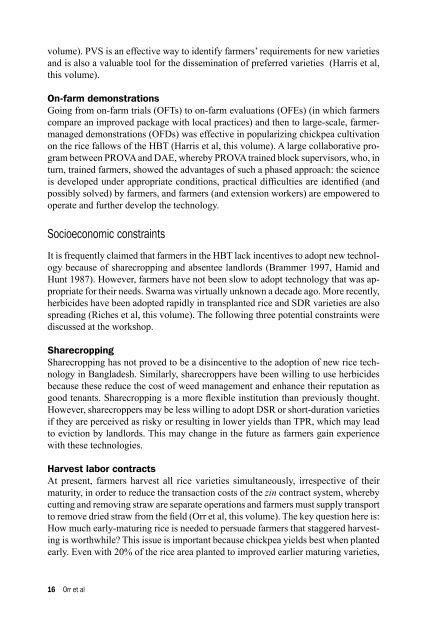Download (2461kB) - University of Greenwich
Download (2461kB) - University of Greenwich
Download (2461kB) - University of Greenwich
- No tags were found...
You also want an ePaper? Increase the reach of your titles
YUMPU automatically turns print PDFs into web optimized ePapers that Google loves.
volume). PVS is an effective way to identify farmers’ requirements for new varietiesand is also a valuable tool for the dissemination <strong>of</strong> preferred varieties (Harris et al,this volume).On-farm demonstrationsGoing from on-farm trials (OFTs) to on-farm evaluations (OFEs) (in which farmerscompare an improved package with local practices) and then to large-scale, farmermanageddemonstrations (OFDs) was effective in popularizing chickpea cultivationon the rice fallows <strong>of</strong> the HBT (Harris et al, this volume). A large collaborative programbetween PROVA and DAE, whereby PROVA trained block supervisors, who, inturn, trained farmers, showed the advantages <strong>of</strong> such a phased approach: the scienceis developed under appropriate conditions, practical difficulties are identified (andpossibly solved) by farmers, and farmers (and extension workers) are empowered tooperate and further develop the technology.Socioeconomic constraintsIt is frequently claimed that farmers in the HBT lack incentives to adopt new technologybecause <strong>of</strong> sharecropping and absentee landlords (Brammer 1997, Hamid andHunt 1987). However, farmers have not been slow to adopt technology that was appropriatefor their needs. Swarna was virtually unknown a decade ago. More recently,herbicides have been adopted rapidly in transplanted rice and SDR varieties are alsospreading (Riches et al, this volume). The following three potential constraints werediscussed at the workshop.SharecroppingSharecropping has not proved to be a disincentive to the adoption <strong>of</strong> new rice technologyin Bangladesh. Similarly, sharecroppers have been willing to use herbicidesbecause these reduce the cost <strong>of</strong> weed management and enhance their reputation asgood tenants. Sharecropping is a more flexible institution than previously thought.However, sharecroppers may be less willing to adopt DSR or short-duration varietiesif they are perceived as risky or resulting in lower yields than TPR, which may leadto eviction by landlords. This may change in the future as farmers gain experiencewith these technologies.Harvest labor contractsAt present, farmers harvest all rice varieties simultaneously, irrespective <strong>of</strong> theirmaturity, in order to reduce the transaction costs <strong>of</strong> the zin contract system, wherebycutting and removing straw are separate operations and farmers must supply transportto remove dried straw from the field (Orr et al, this volume). The key question here is:How much early-maturing rice is needed to persuade farmers that staggered harvestingis worthwhile? This issue is important because chickpea yields best when plantedearly. Even with 20% <strong>of</strong> the rice area planted to improved earlier maturing varieties,16 Orr et al
















